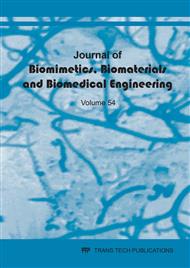[1]
I. Kim, J. Kim, D. Lee, Sulfonic acid functionalized deoxy cellulose catalysts for glycerol acetylation to fuel additives Appl. Catal. A Gen 482 (2014) 31–37.
DOI: 10.1016/j.apcata.2014.05.018
Google Scholar
[2]
F. Frusteri, G. Arena, C. Bonura, C. Cannilla., L. Spadaro, O. Blasi, Catalytic etherification of glycerol by tert-butyl alcohol to produce oxygenated additives for diesel fuel, Appl. Catal. A Gen. 367 (2009) 77–83.
DOI: 10.1016/j.apcata.2009.07.037
Google Scholar
[3]
J. Gui, X. Cong, D. Liu, X. Zhang, Z. Sun, Novel Brønsted acidic ionic liquid as efficient and reusable catalyst system for esterification, Catalysis Commun. 5 9 (2004) 5473–5477.
DOI: 10.1016/j.catcom.2004.06.004
Google Scholar
[4]
J. Xua, L. Chen, H. Qu, Y. Jiao, J. Xie, G. Xing, Preparation and characterization of activated carbon from reedy grass leaves by chemical activation with H3PO4, Appl Surfac Sci. 320 (2014) 674–680.
DOI: 10.1016/j.apsusc.2014.08.178
Google Scholar
[5]
K. Klepacova. D. Mravec, M. Bajus, Brønsted acidic ionic liquids: thedependence on water of the Fischer esterification of acetic acid and ethanol. Appl. Catal. A Gen. 294 (2005) 141–147.
Google Scholar
[6]
J.A Melero, R. V. Grieken, G. Morales, M. Paniagua, Acidic mesoporous silica for the acetylation of glycerol: synthesis of bioadditives to petrol fuel, Energy & Fuel. 21 (2007) 1782–1791.
DOI: 10.1021/ef060647q
Google Scholar
[7]
C. Masoumeh, R. Mahjoub Ali, A. Azzam, Zirconium modified mesoporous silica as an efficient catalyst for the production of fuel additives from glycerol, Catalysis Comm. 110 (2018) 1-4.
DOI: 10.1016/j.catcom.2018.02.021
Google Scholar
[8]
R. R. Josefa, L. Soriano, M. S. Pilar, L. A. Jorge, P. M. J. Luiz, J. Paya, Microscopy characterization of silica-rich agrowastes to be used in cement binders: bamboo and sugarcane leaves, Micro Microanaly. 21 5 (2015) 1314 – 1326.
DOI: 10.1017/s1431927615015019
Google Scholar
[9]
P. Velmurugan, J. Shim, K.J Lee, M. Cho, S.S Lim, S.K Seo, K.M Cho, K.S Bang, B.T Oh, Extraction, characterization, and catalytic potential of amorphous silica from corn cobs by sol-gel method, J of Ind and Eng Chem. 29 (2015) 298-303.
DOI: 10.1016/j.jiec.2015.04.009
Google Scholar
[10]
M. Ahmad, F. Rafida, A. A. A. Raman, S. K. Bhargava. Synthesis and activity evaluation of heterometallic nano oxides integrated ZSM-5 catalysts for palm oil cracking to produce biogasoline, Energy Convers and Manag. 119 (2016) 352 – 360.
DOI: 10.1016/j.enconman.2016.04.069
Google Scholar
[11]
B. G. Khadijeh, A. Nilofar, Y. M. Ambar, M. W. Samsudin, Mesoporous phosphated and sulphated silica as solid acid catalysts for glycerol acetylation, Chem Papers. 68 9 (2014) 1194 – 1204.
DOI: 10.2478/s11696-014-0550-x
Google Scholar
[12]
P. Ferreira, I.M Fonseca, A.M Ramos, J. Vital, J.E Castanheiro, Acetylation of glycerol over heteropolyacids supported on activated carbon. Catalysis Commun. 12 7 (2011) 573–576.
DOI: 10.1016/j.catcom.2010.11.022
Google Scholar
[13]
W. Roschat, T. Siritanon, B. Yoosuk, V. Promarak, Rice husk- derived sodium silicate as a highly efficient and low-cost basic heterogeneous catalyst for biodiesel production. Energy Convers and Manag. 119 (2016) 453 – 462.
DOI: 10.1016/j.enconman.2016.04.071
Google Scholar
[14]
N. Hindryawati, G.P Maniam, M.R Karim, K.F Chong, Transesterification of Used cooking oil over alkali metal (Li, Na, K) supported rice husk silica as potential solid base catalyst. J. Int an Eng Sci and Techn. 17 2 (2014) 95-103.
DOI: 10.1016/j.jestch.2014.04.002
Google Scholar
[15]
A.G.A Siregar, R.Manurung, Taslim, Synthesis and characterization of sodium silicate produced from corncobs as a heterogeneous catalyst in biodiesel production, Indonesian J of Chem. 21 (2021) 88–96.
DOI: 10.22146/ijc.53057
Google Scholar
[16]
M. Chamack, M. Ali Reza, A. Azzam. Zirconium modified mesoporous silica as an efficient catalyst for the production of fuel additives from glycerol, Catalysis Commun. 18 (2018) 5-8.
DOI: 10.1016/j.catcom.2018.02.021
Google Scholar
[17]
I. Dosuna-Rodriguez, C. Adriany, E.M Gaigneaux. Glycerol acetylation on sulphated zirconia in mild condition, Catalysis Today. 167 (2011) 53 – 56.
DOI: 10.1016/j.cattod.2010.11.057
Google Scholar
[18]
U. I. Nda-Umar, I. Ramli, E. N. Muhamad, Y. H. Taufiq-Yap, N. Azri, Synthesis and characterization of sulfonated carbon catalysts derived from biomass waste and its evaluation in glycerol acetylation Biomass Convers and Biorefinery. (2020).
DOI: 10.1007/s13399-020-00784-0
Google Scholar
[19]
I. Thushari, S. Babel, Preparation of solid acid catalysts from waste biomass and their application for microwave-assisted biodiesel production from waste palm oil, Waste Manag Res. 36 (2018) 719–728.
DOI: 10.1177/0734242x18789821
Google Scholar


